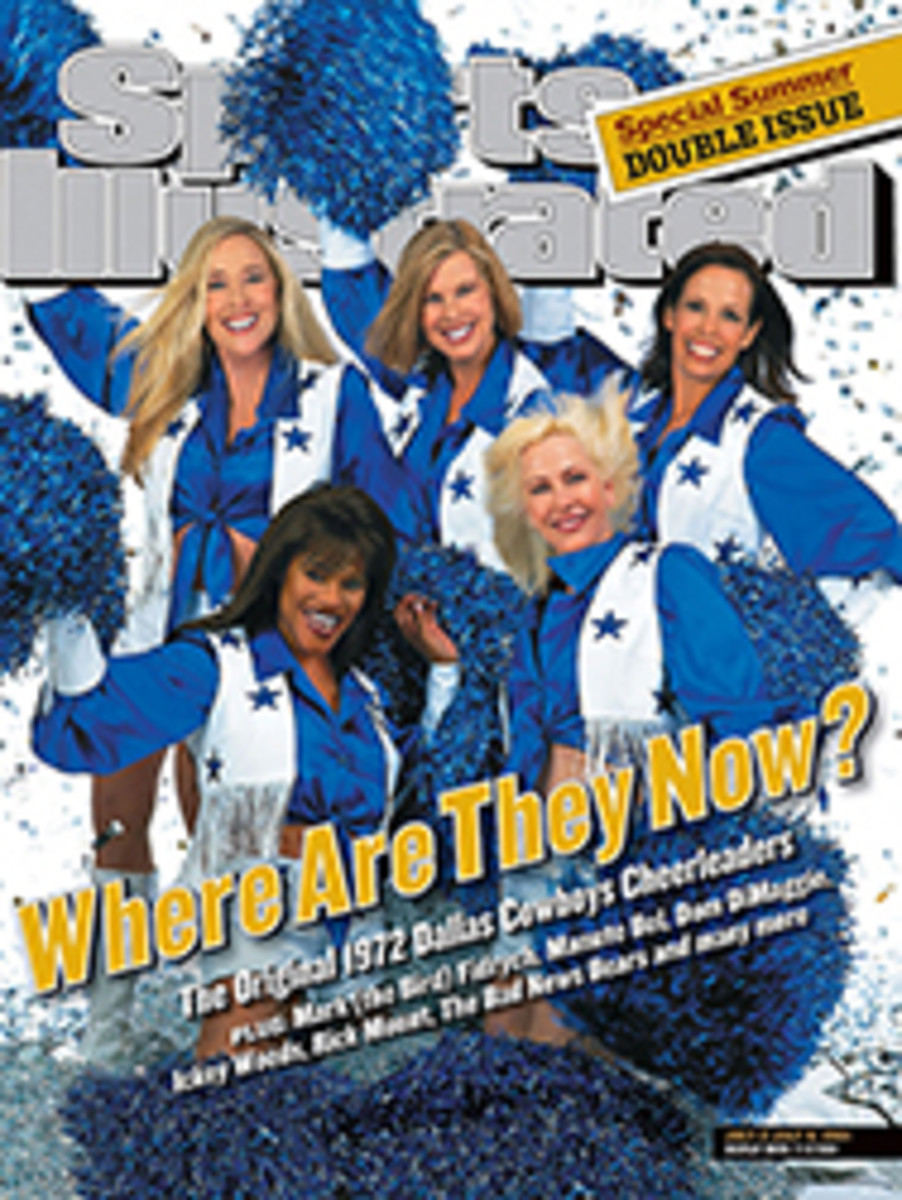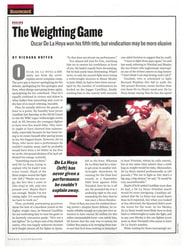
Notebook
Westchester Out, New TPC In?
Changing Course
The Buick Classic at Westchester Country Club, 25 miles northeast
of New York City, always attracts one of the best fields of the
year. To a man, the Tour pros love the traditional feel of the
club's 6,722-yard, par-71 West course and the demands it makes on
their games. A year ago Westchester played tougher, relative to
par, than any nonmajor venue on Tour besides the TPC at Sawgrass.
"It would be great to play more courses like this," says Billy
Andrade, who won the Classic in 1991.
Thunderstorms tamed Westchester last week, and Sergio Garcia
became the Classic's youngest champion, making 21 birdies and an
eagle to tie the tournament record with a 16-under 268, three
strokes ahead of Scott Hoch. Garcia, though, may be the
penultimate champion at Westchester. When the contract between
the Tour and the club expires after next year's tournament, the
event could move to another course in the New York metropolitan
area. One potential site is Ferry Point Park, a Jack
Nicklaus-designed public course under construction in the Bronx
beneath the Whitestone Bridge, which links the Bronx to Queens
and Long Island. A discussion has been held between the Tour and
Nicklaus's company about putting the Tournament Players Club
brand on Ferry Point, and where the TPC brand goes, the Tour
usually follows.
The Tour pays Westchester one of the highest site fees ($800,000)
on the schedule for use of the club, but that isn't the only
reason that the Tour is looking elsewhere. All that money doesn't
buy complete control of the Westchester Country Club grounds. The
club has an additional 18 holes, and they remain open to the 985
members during the tournament. Four of those holes abut the
tournament course, and errant shots by members sometimes stray
there. A portion of the men's locker room, usually the inner
sanctum for the pros, also remains open to members during
tournament week.
Unlike most PGA Tour events, which are locally managed, the
Classic is one of eight tournaments the Tour stages, and the
circuit's officials are acting as if they suddenly discovered
that the course is near Manhattan. "We want to make this a New
York event," says Robert Dale Morgan, the Tour's vice president
of championship management. Peter Mele, the Classic's tournament
director, has called clubs throughout the metropolitan area to
gauge their interest in holding the tournament.
Winged Foot, a couple of exits south on the Hutchinson River
Parkway from Westchester, expressed interest if the Tour would
throw in a Tour championship or a World tour event. Ridgewood,
the Paramus, N.J., club that hosted May's Senior PGA, has also
been mentioned as a potential site. Rotating the tournament among
courses in New Jersey, Long Island and Westchester County--and
don't forget Ferry Point--is a possibility. "It's the greatest
city in the world," Mele says. "It has so much to offer from a
marketing standpoint."
The players reacted to the possibility of leaving Westchester
with words like "shame" and "tragedy." The course, which was
designed by Walter Travis and opened in 1919, is a rarity on the
Tour. "This is one of the nicest we play," says Corey Pavin. "We
love the old-style courses: shorter, smaller greens, tighter
fairways. They don't have forced carries or big, undulating
greens with ledges off the sides."
Besides Westchester, only a handful of similar courses--Riviera
(Nissan Open), Colonial (MasterCard Colonial), Warwick Hills
(Buick Open) and Cog Hill (Western Open)--remain on Tour. Most of
the other older tracks have been rendered obsolete because they
couldn't handle large crowds or because the Tour built a TPC
course nearby.
The players recognize that although they make more money today,
they've given something up. Says 46-year-old Mike Reid, "The
former governor of New York Theodore Roosevelt said it best:
'When money comes in the door, sports goes out the window.' We
still have a game played by terrific players with integrity. If
the Tour has compromised its integrity anywhere, it has been by
going to courses that demand [only] two things: hit hard and putt
well. The idea of developing a complete game--unless your goal is
to win the Open--is passe. When courses don't require us to do
things the way we used to, why bother?"
Reid's sentiments are shared by some members of the younger set.
Tiger Woods, who opened with a 75 but came back with 66 in the
second round, said, "The best thing about this course is that you
are rewarded for shooting good rounds. If you shoot in the
mid-60s, you're definitely going to move up." Woods's 66 lifted
him from 118th to 30th, and he eventually finished 16th, 12 shots
behind Garcia.
The future of the Classic will be determined in a few months.
After completing negotiations on its new TV package and updating
its sponsorship agreement with Buick, the Tour will decide
whether to move from Westchester, maybe even into New York
City. --Ivan Maisel
COLOR PHOTO: DARREN CARROLL Woods finished 12 shots behind Garcia in what may have been the next-to-last Classic at Westchester.
COLOR PHOTO: TONY TRIOLO
Scar Power
Retief Goosen was one of the lucky ones. His three-putt from 12
feet on the 72nd hole of the U.S. Open could have been a
career-killer, but he bounced back to beat Mark Brooks in a
playoff, and what could've gone down as a gaffe for the ages was
reduced to a footnote. Not all the golfers who've yipped a big
putt, like Ed Sneed (below), have been as fortunate.
DOUG SANDERS He needed only a four at the 18th to edge Jack
Nicklaus and win the 1970 British Open at St. Andrews. After his
35-foot birdie try came up short, Sanders had a left-to-right
three-footer. He slapped it right and lost a playoff.
Career-killer? Definitely. The miss became Sanders's defining
moment.
ED SNEED Three up with three to play in the 1979 Masters, he
missed a three-footer for par at 17, left a six-footer for the
win hanging on the lip at 18 and then lost to Fuzzy Zoeller in a
playoff. Career-killer? Yes. Sneed never again contended in a
major and by '85 had retired as a full-time player.
SCOTT HOCH After stepping away from a two-footer for the win on
the first hole of a playoff against Nick Faldo at the 1989
Masters, Hoch forgot the read, pulled the putt and lost the
playoff on the next hole. Career-killer? Nope. Although he's
still without a victory in a major, Hoch has won five Tour events
since 1994, including at Greensboro this April.
MIKE REID Standing on the 16th tee at Kemper Lakes in the final
round of the 1989 PGA, he had a three-shot lead over Payne
Stewart. Stewart, playing ahead of Reid, birdied the 18th hole as
Reid drove into the water and made bogey. Reid then
double-bogeyed the 17th and handed Stewart his first major.
Career-killer? Absolutely. Reid hasn't finished among the Tour's
top 70 money-winners in 10 years.
BERNHARD LANGER He had the ultimate pressure putt to end his match
against Hale Irwin at the 1991 Ryder Cup, the War by the Shore: a
six-footer to decide the Cup. He missed. Career-killer? No. Like
Goosen, he found almost immediate redemption, winning the German
Masters the next week.
DAVIS LOVE III He could've won the 1996 U.S. Open at Oakland Hills
but finished bogey-bogey to lose by a stroke. The latter came
when he left a slick, downhill 20-footer three feet short and
dribbled his par putt over the left edge. Career-killer? Almost.
It took him more than a year to win again, at the '97 PGA for his
only victory in a major.
Trust Me
Any Monday finish is anticlimactic, regardless of the tournament.
It doesn't matter whether play is extended because of a playoff
at the U.S. Open or a rain delay at the Buick Classic; the extra
day is inconvenient for the golfers and irritating to the fans. A
three-hole playoff, a 54-hole Tour event--do whatever it takes to
wrap up a tournament on Sunday, while we still care.
Threesomes
What do these players have in common?
Hale Irwin
Jack Nicklaus
Jay Sigel
They're the only Senior tour members to win five or more USGA
titles. Irwin has five, Nicklaus eight and Sigel five.
Feedback
Will Tiger Woods ever win the Grand Slam?
Yes 60%
No 40%
--Based on 4,286 responses to our informal survey
Next question: Who choked the worst in a major? Stewart Cink
(2001 U.S. Open), Scott Hoch ('89 Masters), Greg Norman ('96
Masters) or Jean Van de Velde ('99 British).
Vote at golfplus.cnnsi.com.
Thesaurus
SYNONYMS for BUNKER
Beach, crater, foxhole, kitty litter, Miami, pit, pot, sandbox,
Sandy Koufax, sheep's pen, splash zone.
Numbers
Which LPGA, PGA or Senior tour player has performed best in the
majors since the start of the 1997 season? The answer: Hale
Irwin, who is shooting for his second consecutive U.S. Senior
Open this week. Here are the golfers with the best scoring
averages in majors over the last 4 1/4 years.
Top 10s Wins Scoring Avg.
Hale Irwin 13 5 69.80
Tiger Woods 12 6 70.17
Gil Morgan 11 3 70.27
Karrie Webb 14 5 70.59
Bruce Fleisher 6 0 70.66
Larry Nelson 7 0 71.18
Juli Inkster 7 3 71.19
Jim Thorpe 4 0 71.24
Se Ri Pak 6 2 71.28

